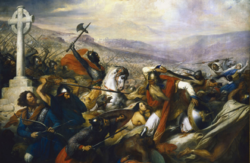Difference between revisions of "Brotherhood of Saint Karl"
| Line 50: | Line 50: | ||
== The First Order (1679-1710) == | == The First Order (1679-1710) == | ||
| − | '''The First Order''' was founded on the command of [[Siguine I of Haense|King Sigmar of Haense]] and its first marshal was the Lord [[Rhys var Ruthern]] who led the order under both King Sigmar and King [[Robert I of Haense]]. He later passed on command to Lord Henrik Kovachev and after him Lord Sergei Stafyr | + | '''The First Order''' was founded on the command of [[Siguine I of Haense|King Sigmar of Haense]] and its first marshal was the Lord [[Rhys var Ruthern]] who led the order under both King Sigmar and King [[Robert I of Haense]]. He later passed on command to Lord Henrik Kovachev and after him Lord Sergei Stafyr until it was finally disbanded by King [[Robert I of Haense]] at the early years of [[Arcas]] and merged into the Haeseni Royal Army. |
=== Foundation of the First Order === | === Foundation of the First Order === | ||
Revision as of 18:34, 14 September 2019
| |||||||||||||||||||||||||
Founded in 1678 by King Siguine I of Haense, the Brotherhood of Saint Karl (New Marian: Ve Oreonir Sant Karleo) began with the merging of the levies of the great Houses of the Kingdom of Hanseti-Ruska. Throughout its duration as the central military force of the Crown, the Brotherhood has been guided by its longstanding tradition of fostering unity, strength, and justice to those sworn to its ranks. Bound by oath and fraternity, the Brotherhood of Saint Karl stood among the preeminent human martial forces during some of humanity’s most trying times.
Founded under the patronage and namesake of Saint Karl Barbanov, the Brotherhood espouses the affinities of this saint: strength, courage, and for the intentions of soldiers. Saint Karl was an instrumental figure in the history of Haense, considered its founder who lived over two centuries ago. It is said that whilst in battle, Saint Karl was struck down and at the verge of death before seeking divine providence and being endowed strength to rise and lead his men to victory. At this act, he vowed to consecrate his life in the name of GOD and formed the foundation of Haeseni civilization as a testament to the blessings of the Seven Skies. In 1564, High Pontiff Theodosius I canonized Duke Karl Barbanov as the patron saint of strength. His name honored the first capital of the newly formed Kingdom of Hanseti-Ruska in 1578, City of Saint Karlsburg.
The Brotherhood of Saint Karl honors the tradition and legacy of Karl Barbanov by espousing the values of the saint into those who pledge to serve the kingdom. Those called to the Crown’s service reflect the stalwart values and cultures of the Highlander people, a sense of fraternity and unity for the defense of those who wish to do harm.
Contents
The First Order (1679-1710)
The First Order was founded on the command of King Sigmar of Haense and its first marshal was the Lord Rhys var Ruthern who led the order under both King Sigmar and King Robert I of Haense. He later passed on command to Lord Henrik Kovachev and after him Lord Sergei Stafyr until it was finally disbanded by King Robert I of Haense at the early years of Arcas and merged into the Haeseni Royal Army.
Foundation of the First Order
During the of the Battle of the Three Hills, marked by the terrain upon which the conflict ensued, King Sigmar I led his levy company composed of levies of the vassalage. As they advanced the stout keep that rested atop the ledge between the three hills, they were met with a barrage of archer fire, causing the formation to diverge. The king himself was separated from his main levy and forced to fallback behind the base of the southernmost hill.
With the forces now split, King Sigmar was to make his choice: charge with his remaining force or recall his forces back. Echoing the hardships of battle and strength, King Sigmar called upon the patronage of his ancestor, Saint Karl, and entrusted his plight to the saint of strength. The army chaplain, Fr. Anselm Gerhard recalled that day when the king saw the countenance of Saint Karl upon the sides of the three hills, each bearing a sword with a crow resting upon the blade. He took that as a sign of courage and strength to maintain his position and against great odds, the Haeseni troops overwhelmed the fortified southern hill. Not long after, their advance of the second hill was met with heavy fire but by midday, the keep had been driven out by King Sigmar’s charge with the colors of Haense flying triumphant along the keep’s facade.
During the procession back to Markev, the soldiers were met with great mirth at their victory. Upon the roof of the main gate, the crow that King Sigmar saw in the field of battle sat upon the crenellations of the wall and flew off as the king entered the city. When King Sigmar called his war council together at the Krepost Palace, he spoke of a charter to consecrate the levies under the patronage of the Saint who had given him a sign of victory at the battle. King Sigmar took his victory as a form of humility by GOD to devote Haense’s forces to Saint Karl. In close collaboration with the levies of the great houses of Haense such as Ruthern, Stafyr, Enthelor, Vanir, and Baruch, the foundation of the Brotherhood was formed as a central Haeseni force, branded to serve GOD, king, and kingdom.
Wars Against the Vaeyl
- Main article: Vaeyl Wars
The first engagement of the Brotherhood with the Vaeyl occurred in 1681, when an expeditionary force led by Lord Marshal Rhys trekked through the Yatl Wastelands in the far south. Roughly 500 brothers traversed toward the south after reports of the Vaeyl Order’s activity were made known to the court of King Sigmar. Upon their arrival, the Brotherhood was met with a powerful blizzard that claimed the lives of almost a third of their regiment.
When the soldiers arrived, they established a fortification at Nekristadt, where they were joined with Imperial knights. The combined human garrison swiftly began defenses in anticipation of the Vaeyl Order’s impending advance. A lone Red Vaeyl soldier approached the gate of Nekristadt and offered peace in exchange for the human forces to surrender. However, the Brotherhood and the Imperial knights declined as they drew their swords and executed the emissary.
Soon thereafter, Red Vaeyl soldiers began to scale the northern wall of Nekristadt. Haeseni archers attempted to keep them at bay as the battle consumed the entirety of the night. As day broke, the Red Vaeyl Order suddenly breached the main gate, ushering in hundreds of the enemy forces into the courtyard. The Brotherhood and the Imperial Knights were reinforced by a regiment of Imperial troops led by the Grand Marshal Ser Roland and were able to outflank and overrun the Vaeyl Order’s formation towards the lake. In the aftermath of the battle, the Brotherhood was tasked by the Imperial Grand Marshal to establish a permanent settlement and fortification to counter succeeding invasions from beyond the southern wall.
In 1691, after successful campaigns against the Red Vaeyl Order, Commandant Rhys var Ruthern led the Brotherhood of Saint Karl in concluding the final stages of what amounted to a decade-long conflict. The Siege of Last Hope solidified the Brotherhood of Saint Karl as the preeminent bulwark against the threat that had loomed over the entire continent of Atlas for over half a century. As the Brotherhood trekked toward the south to advance into another excursion to repel the Vaeyl Order’s presence from Atlas, the Brotherhood had experienced great success. Before the battle, Ferdinand Karl offered a prayer on behalf of the men in which before donning their helmets, they saw a Crow perched atop a stone, a sign that the Kingdom of Haense would emerge victorious over the bases of the Vaeyl at Last Hope.
Merge into the Haeseni Royal Army
WIP
The Second Order (1724-present)
The Second Order was founded by order of King Andrew III of Haense after the disastrous defeats that the Haeseni Royal Army had suffered during the War of the Two Emperors. Its first Marshal was Lord Otto Kortrevich who was later replaced by its current Marshal Lord Wilheim Barclay due to the absence of Lord Kortrevich. The revitalization of the Brotherhood saw some early success in the Three Months War and also the Lotharingian Revolt
Three Months War
WIP
Lotharingian Revolt
WIP
Traditions
Since the Brotherhood of Saint Karl is devoted to the saint that bears its name, it is typical for the chaplain or an officer to be delegated the task to lead in prayer prior to battle. The Brotherhood is heavily rooted in the Church of the Canon, and as such, maintains staunch traditions of faith. Prayer is begun in New Marian, beginning with the phrase Iv Joveo Maan ag Koeng before beginning the intentions. Soldiers typically light three candles surrounding a figurine of Saint Karl Barbanov to represent three petitions: strength, courage, and prudence.
Followed by prayer, the Brotherhood marches together to the tomb of kings and offers a moment to honor the liege lords of the realm. The tradition concludes with a final petition to Exalted Siegmund to lead the devoted Highlandic warriors to victory with the insight and arm of the Seven Skies’ Exalted.
Oath of Saint Karl
The Oath of Saint Karl is taken by every brother that swears into the Brotherhood after passing through the rank of Initiate. Once sworn he is considered a Brother of Saint Karl and the extended arm of the King of Haense. Usually taken in the Tomb of Kings in front of the deceased Haeseni monarchs in the presence of his Commander, Sergeant and fellow Brothers.
‘To my left I see my fellow brothers, to the right I see the same.
For all in the world, we fight for the peace of this land.
Through God, he gave us stewardship of the realm.
Through stewardship, we gained the knowledge of diligence and prudence.
Through diligence, we may conquer all without fault.
And if I should falter in my course, send me never to the skies above.
If I should succeed, bestow unto me His blessings, forevermore.
For, now I march into a valley through which there is no path.
And the stones cascade behind me, to seal my retreat.
Though in this valley, I find my Brothers;
Now I am named Guardian of My Homeland.
Should I falter, my shield shall turn to ash;
But I shall not falter.’
Organization
The current formation of the Brotherhood is organized into three Chapters who all serve different purposes on the field of combat. With their unique fighting styles all the chapters are led by a Commander and divided into sections all led by individual Sergeants
Chapter of the Crow
WIP
Chapter of the Destrier
WIP
Chapter of the Black Cross
WIP

